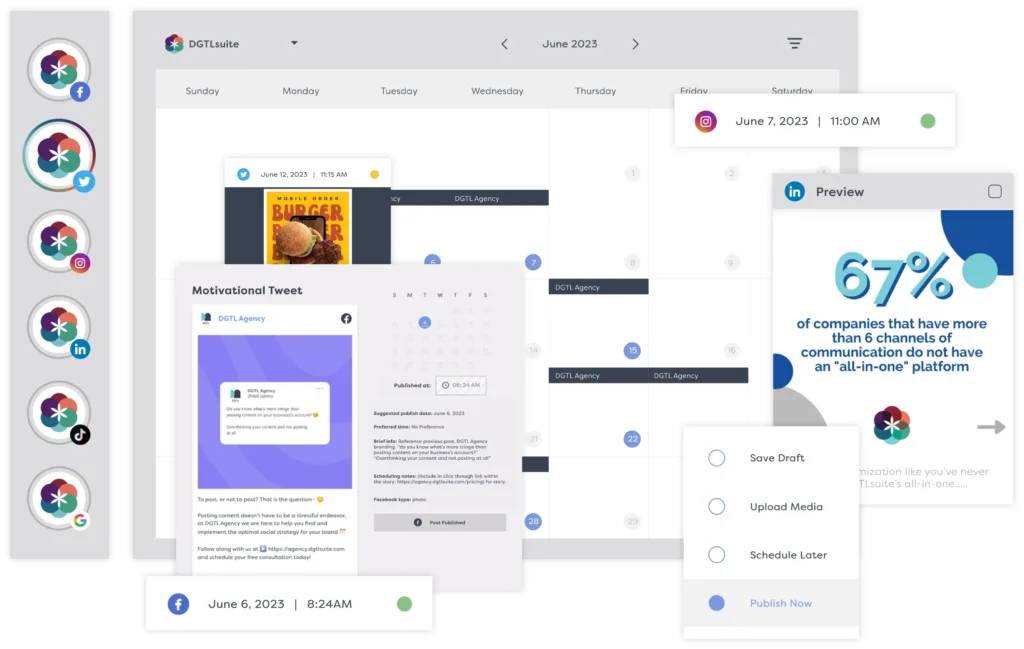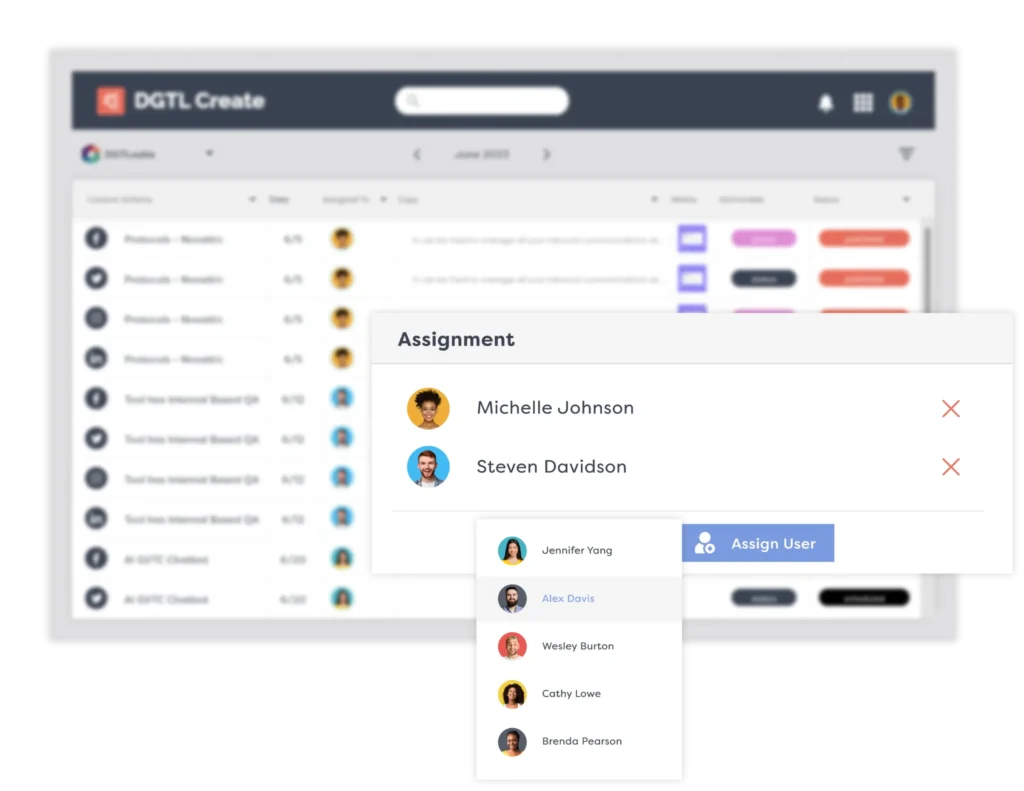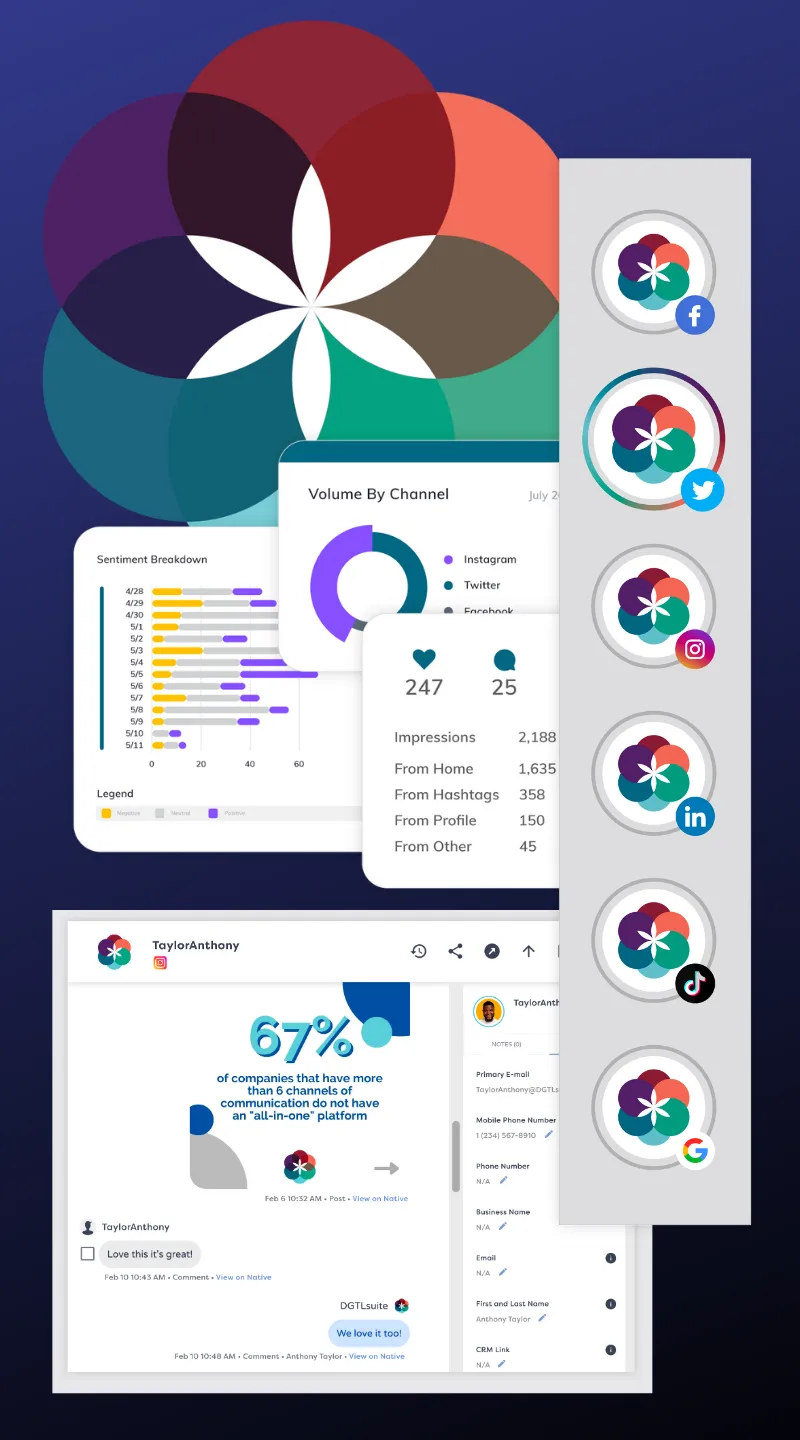Ever feel like you’re drowning in notifications and scrambling to keep up with a never-ending stream of posts, comments, and messages? Managing multiple social accounts can be overwhelming and leave you wondering how anyone keeps it all together.
One moment, you’re creating the perfect Instagram story and the next, you’re drafting a professional post for LinkedIn. Every platform has its quirks and demands, and it’s enough to make your head spin.
The reality is juggling multiple social media channels isn’t easy—but it doesn’t have to be pure chaos either. With a little strategy, you can turn the overwhelm into a smooth system that actually works for you.
In this guide, we’ll break down common challenges and give you practical tips to keep your accounts thriving without feeling like you’re constantly on the edge of burnout.
The Challenges of a Multi-Channel Social Media Strategy
Managing multiple social media accounts for a business or brand isn’t as simple as just hitting “post” (although we wish it was). Each platform comes with its own rules, audience expectations, and quirks, which is why it’s so important to develop a well-coordinated approach.
Here are some of the main challenges you might encounter:
It Takes a Lot of Time to Keep Up
Managing multiple social media accounts can quickly take over your life. Between creating unique posts, scheduling content, replying to comments, and monitoring analytics, it can feel like a never-ending to-do list.
Each platform demands attention and a tailored approach, turning what might seem like a simple task into a complex juggling act. Without a clear plan, it’s easy to get buried in notifications and spend hours each day trying to keep up.
The constant pressure to stay active and engage can leave you drained, and one slip in consistency can mean losing momentum—and even followers.
Your Voice Can Get Lost in the Noise
When managing several social media platforms, it’s all too easy for your brand voice to become inconsistent.
What you say on Instagram might not translate well to LinkedIn or X (Twitter), and if you’re not careful, each account can start to feel disconnected from your overall brand. This inconsistency can confuse your audience and dilute the impact of your messaging.
Missing the Conversation Leaves Followers Cold
One of the biggest struggles of handling multiple social media accounts is staying engaged with your audience. The sheer volume of messages, comments, and mentions can quickly get overwhelming, which often makes it hard to respond promptly and meaningfully.
If you’re not engaging, you’re missing out on building a genuine connection with your followers. They notice when your replies are delayed or when you’re simply not present.
Keeping Up with Different Demands
Creating content for several social media channels is exhausting. Each platform has its own expectations—short, snappy posts for X, visually striking content for Instagram, and professional insights for LinkedIn.
The pressure to continuously come up with fresh, platform-specific content can lead to burnout. And if you fall behind on one channel, it’s easy for things to spiral, leaving your presence inconsistent.
Getting Lost in the Data
With multiple social media accounts, tracking performance metrics can feel like a full-time job in itself. There’s engagement to monitor, clicks to track, and reach to measure, all across different platforms. Piecing together the data to find patterns or measure success often leaves you with information overload.
Without the right focus, it’s easy to get lost in numbers and struggle to figure out what’s actually working and what’s not. The inability to clearly see results can make it difficult to adjust strategies effectively, which leaves you spinning your wheels.
Best Tips to Manage Multiple Social Media Accounts
Handling multiple social media accounts might feel like herding cats—one minute, you’re posting a tweet, the next you’re dealing with DMs on Instagram. It’s a whirlwind that can quickly leave you overwhelmed. But don’t worry—you’re not alone in the struggle, and there are ways to make it easier.
Let’s jump into some practical tips to turn that chaos into something you can actually manage.
1. Build a Content Calendar
A content calendar is an invaluable tool for managing two or more social media accounts. It helps you plan out what content you’ll post and when, so you’re never caught off guard or scrambling for last-minute ideas.
Start by outlining key dates, events, and campaigns relevant to your brand. Then, fill in the gaps with planned posts, ensuring a balanced mix of evergreen content and timely, trend-focused posts.
This approach not only keeps you organized but also allows you to maintain a consistent posting schedule, which is a must for building and keeping an engaged audience.
2. Batch Your Social Media Tasks
Instead of tackling different social media tasks throughout the day, try batching them together to improve productivity and reduce distractions.
Dedicate specific blocks of time to focus on one type of task at a time. For example, reserve one day (or a few hours) solely for content creation. Use this time to draft posts, design visuals, or schedule content for the week ahead.
On another day, set aside time for engagement—responding to comments, answering direct messages, and interacting with your followers. This focused approach makes sure you’re fully present when engaging with your community, strengthening connections and increasing brand loyalty.
Finally, allocate a separate period for reviewing analytics and performance metrics. Diving deep into your data allows you to assess what’s working, adjust your strategies, and refine future posts.
3. Tailor Your Content to Each Platform
Creating a one-size-fits-all post for every social media platform won’t cut it. Each platform has its own personality, audience, and expectations, so you need to adjust your content accordingly to make the most impact. Here’s what works best on some popular platforms:
- Instagram: This platform thrives on eye-catching visuals, like high-quality photos, graphics, and videos. Pair them with engaging yet concise captions and use hashtags to maximize visibility.
- LinkedIn: This is the space for thought leadership and professional insights. Share industry news, in-depth articles, and career advice while maintaining a more formal tone to engage with professionals.
- X (Twitter): Quick, snappy content rules here. Craft tweets that are punchy, attention-grabbing, and often conversational. Use trending hashtags and take part in relevant discussions to increase your reach.
- Facebook: Engage with a mix of photos, videos, articles, and live sessions, encouraging interaction through comments, likes, and shares.
- TikTok: Short-form, entertaining videos that embrace trends and creative storytelling perform well here.
 4. Engage With Your Audience
4. Engage With Your Audience
Posting great content is just the first step—you’ve got to get in there and actually talk with your audience if you want to build loyalty and stand out.
Dedicate a bit of time each day to jump into the comments, reply to direct messages, and acknowledge mentions. When someone reaches out, don’t just give them a canned response—show that you’re listening and that you actually care about what they have to say. A thoughtful reply or even a quick “thank you” can make a big impact.
But engagement doesn’t stop there. Take part in conversations happening in your niche, share posts from your followers, and respond to feedback—whether it’s glowing praise or constructive criticism.
Your followers want to feel seen and heard, and when you’re genuinely present, it builds trust and keeps people coming back for more. Plus, it makes your brand feel human, relatable, and approachable, which is what social media is all about.
5. Repurpose Past Content
Don’t let great content gather digital dust—repurposing is a smart way to maximize your reach without reinventing the wheel every time.
Start by identifying your top-performing content, like a successful blog post or popular social media update. From there, transform it into new formats that fit other platforms.
For example, break down a detailed blog post into a series of visually appealing infographics for Pinterest. Take key takeaways and create engaging, bite-sized video clips for TikTok or Instagram Reels. You can even turn the main points into a Twitter thread to spark conversation.
Repurposing content not only saves you time but also allows you to reach different audiences where they’re most active. It breathes new life into existing content and keeps your social media accounts fresh and engaging.
6. Automate Where Possible (But Be Careful)
Automation can be a lifesaver when you’re managing multiple social media accounts. It takes the pressure off by allowing social media managers to schedule posts ahead of time, maintain a consistent posting schedule, and free up time for other tasks.
However, there’s a catch—automation can quickly turn your presence stale if you’re not careful. The key is to find a balance.
- Automate post scheduling: Use a social media management platform like DGTLsuite to plan and schedule your posts in advance. This makes sure your content goes live at the optimal times for engagement, even when you’re busy.
- Monitor comments and mentions: Automation shouldn’t mean ignoring your audience. Keep an eye on what people are saying about your brand and respond in real time when necessary.
- Leave room for real-time engagement: Scheduled posts are great, but make sure you’re also showing up in the moment. Genuine, spontaneous interactions are what make your brand feel human and relatable.
- Avoid generic responses: Automation can handle routine tasks, but responding to comments, messages, or questions with the same canned response can harm your authenticity.
Automation is a tool, not a replacement for personal connection—use it wisely to save time without losing your brand’s voice.
7. Track Analytics Regularly
If you want to know whether your social media efforts are paying off, you’ve got to keep a close eye on your analytics.
Regularly tracking key metrics like engagement rates, reach, clicks, and conversions gives you a clear picture of what’s working and what needs an upgrade.
By analyzing this data, you can spot trends, understand your audience’s preferences, and fine-tune your content strategy accordingly. Maybe certain posts drive more interaction, or a particular format resonates better.
Use built-in analytics tools on platforms like Instagram, Facebook, and X, or go for more robust third-party social media management tools if you manage multiple accounts. The data can help you identify your best-performing content, refine posting schedules, and even decide which platforms deserve more focus.
8. Create a Social Media Playbook
A social media playbook can simplify things by serving as a handy guide to keep everyone aligned. This resource outlines your brand’s tone, style, visuals, preferred hashtags, and even how to handle tough interactions so you have a consistent voice across all platforms.
Fill it with examples of top-performing content, a list of do’s and don’ts, and platform-specific tips for creating engaging posts. When new team members come on board, this playbook makes it easy for them to catch up and maintain your brand’s standards.
Rather than stifling creativity, it provides a strong foundation to keep your message cohesive while giving enough room for fresh ideas.
 9. Choose The Best Social Media Management Tool
9. Choose The Best Social Media Management Tool
When it comes to managing multiple social media accounts, finding the right tool can make or break your strategy. With so many options, it can feel a bit like navigating a maze, but focusing on what truly matters will lead you to the perfect fit.
Here’s what to keep an eye out for:
- Platform compatibility: Make sure the tool works seamlessly with all your accounts, whether you’re posting on Instagram, engaging on Facebook, tweeting on X, or sharing insights on LinkedIn.
- Scheduling and automation: Save time and sanity by choosing a tool that lets you schedule posts in advance, automate repetitive tasks, and maintain a steady stream of content.
- Analytics and reporting: Get the full picture with detailed data on engagement, reach, clicks, and conversions. Know what works, what flops, and how to adjust your strategy.
- User-friendly interface: Nobody wants to wrestle with clunky software. Go for a tool that’s intuitive and easy to use.
- Collaboration features: Managing accounts with a team? Look for tools with shared calendars, task assignments, and approval workflows to keep everyone on the same page.
- Content creation tools: Bonus points for tools that let you create or tweak posts directly, adding visual flair or quick edits.
- Customer support: Reliable support can be a lifesaver when you hit a snag or need extra guidance.
Speaking of the best social media management tool, here’s one that has all the features you need to handle multiple social media platforms.
How DGTLsuite Can Help You Manage All Social Media Platforms
Multi-platform social media marketing doesn’t have to feel like a never-ending race. DGTLsuite is here to make things simple, organized, and surprisingly stress-free.
 Whether you’re handling content for a single brand or juggling multiple social networks, DGTLsuite brings all the tools you need together in one place, helping you get more done in less time—and with way less hassle. Here’s how it works its magic:
Whether you’re handling content for a single brand or juggling multiple social networks, DGTLsuite brings all the tools you need together in one place, helping you get more done in less time—and with way less hassle. Here’s how it works its magic:
Save Time and Simplify Content Creation
Imagine having all your social posts planned, created, and scheduled without breaking a sweat. DGTLsuite’s cross-network scheduling lets you do just that.
Focus more on crafting creative strategies and less on the repetitive grind so your brand consistently stands out without draining your energy.
Everything in One Place
No more scattered content. With DGTLsuite, you can view all your published and scheduled posts in either a calendar or a list view.
This way, you get a full snapshot of your campaigns, spot any content gaps, and collaborate in real time with your team—keeping everyone on the same page.
Make Collaboration a Breeze
Its collaborative features make coordinating campaigns with team members or partners effortless. Plan, schedule, and track your posts without endless email chains while keeping your messaging and brand identity consistent.
Features That Simplify Your Workflow
Make your workflows as smooth as they can be with these capabilities:
- Draft posts with ease: Plan your topics, gather feedback, and schedule posts for multiple platforms easily.
- Approval made simple: Get users to review and approve content effortlessly.
- Quick responses: Manage messages, comments, and interactions across all platforms in one unified stream.
- User permissions control: Fine-tune publishing and response permissions for your team to keep everything secure and consistent.
 Organize Your Assets
Organize Your Assets
DGTLsuite’s integrated media library lets you keep your files and content assets in check. Upload, categorize, and plan social media posts swiftly, and find what you need without endless digging.
Leverage User-Generated Content
Easily collect and manage user-generated content (UGC) with DGTLsuite. Save brand-relevant posts directly into your content library, making relatable content creation a breeze. Plus, a powerful search feature makes it easy to find specific assets quickly and painlessly.
The All-in-One Social Management Solution
DGTLsuite makes social media management seamless by combining engagement, creation, and analytics tools into one powerful platform:
- Engage: Manage every conversation from one inbox so you never miss a beat.
- Create: Organize, plan, and publish across all platforms effortlessly.
- Analyze: Track your success with detailed social data and customizable reports to guide your next moves.
Want to give this social media management software a try? Book a discovery call today and see how DGTLsuite can perfect your strategy.
FAQs About Managing Multiple Social Media Accounts
How do I keep track of posts for multiple accounts without getting overwhelmed?
Use a content calendar to plan and schedule posts in advance. Social media management tools can also help centralize your tasks, keeping everything in one place.
Should I create the same content for every platform?
Not necessarily. Each platform has its own audience and content style. Tailoring your posts for each platform increases engagement and resonates better with specific audiences. Customizing content shows your audience that you understand what they want.
How often should I post on each social media account?
Posting frequency depends on the platform and your audience. For example, X often requires multiple posts a day, while Instagram and LinkedIn can thrive on fewer, higher-quality posts.
What’s the best way to engage with my followers across platforms?
Dedicate time daily to respond to comments, messages, and mentions. Use social media management tools to centralize your responses, making it easier to stay engaged. Being responsive shows your followers that you genuinely care.
How can I measure the success of my social media strategy?
Track key metrics like engagement rates, follower growth, reach, clicks, and conversions using built-in platform analytics or third-party tools. Regular analysis helps you understand what resonates with your audience and what needs adjusting. Data-driven insights keep your strategy on the right track.






